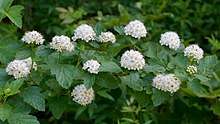Physocarpus opulifolius
Physocarpus opulifolius, known as common ninebark,[2] Eastern ninebark, Atlantic ninebark, or simply ninebark, is a species of flowering plant in the rose family Rosaceae, native to eastern North America.
| Physocarpus opulifolius | |
|---|---|
 | |
| Inflorescences | |
| Scientific classification | |
| Kingdom: | Plantae |
| Clade: | Tracheophytes |
| Clade: | Angiosperms |
| Clade: | Eudicots |
| Clade: | Rosids |
| Order: | Rosales |
| Family: | Rosaceae |
| Genus: | Physocarpus |
| Species: | P. opulifolius |
| Binomial name | |
| Physocarpus opulifolius (L.) Maxim. 1879[1] | |
Description
It is a mound-shaped deciduous shrub with alternate, simple leaves, on arching stems. It has a height from 1–3 m (3–10 ft) and a spread of 1–2 m (4–6 ft).[3] The leaves vary from 3–12 cm (1–5 in) in length, with palmately veined lobes.[4] It is fast-growing, insect- and disease-resistant, and drought-tolerant.[5] The species is adaptable to a very wide range of soil and site conditions, from moist to dry, acid to alkaline, and gravelly to heavy clay; and can grow in partial shade to full sun.[6] The 5-petaled, 6–8 mm (0.24–0.31 in) diameter flowers form in corymbs.[6] The flowers are white to pinkish, blooming from May to June in North America.[6] In Missouri the fruits ripen from August to early October and are small, dry pods hanging in drooping, papery clusters. The bark peels off in thin papery strips, resembling the number nine in shape, exposing brown inner bark which is the origin of the common name.[6]

Range
Physocarpus opulifolius is found in eastern North America on rocky hillsides and banks of streams[4] as well as in moist thickets, especially in counties south of the Missouri River.[3] There is also a scarcely distinguishable form in the Rocky Mountain region and the Pacific Northwest.[7] Its native range is from New York to Minnesota and South Dakota, south to Florida, Arkansas and Kansas. But it can be found from Quebec west to Minnesota, South Dakota and Colorado, south to Oklahoma to Georgia and north to New York.[6] The shrub is an escape, or a wild plant formerly cultivated, northeastward.[5]
Uses
The ability of P. opulifolius to grow in harsh conditions makes it especially suitable for erosion control on banks.[3] But it is also grown for its ornamental foliage. Numerous cultivars have been developed, of which 'Dart's Gold',[8] 'Diabolo',[9] and Lady in Red = ‘Tuilad’[10] have gained the Royal Horticultural Society's Award of Garden Merit.[11] Newer cultivars offer different foliage color as well as smaller overall plant size.[12]
Ecology
It is a larval host for the dimorphic eulithis,[13] for Macaria abruptata,[14] the white spring moth, Ancylis spiraeifoliana,[15] blinded sphinx moth, and possibly the bluish spring moth.[16] The larvae have been recorded on the raspberry leafroller.
Notes
| Wikimedia Commons has media related to Physocarpus opulifolius. |
- Physocarpus opulifolius Tropicos.org. Missouri Botanical Garden. 23 Jan 2012
- "BSBI List 2007". Botanical Society of Britain and Ireland. Archived from the original (xls) on 2015-01-25. Retrieved 2014-10-17.
- "Physocarpus opulifolius". Kemper Center for Home Gardening. Missouri Botanical Garden. Retrieved 25 September 2011.
- Guy Nesom, 2000. Atlantic ninebark: Physocarpus opulifolius (L.) Maxim., Plant Symbol = PHOP. USDA Plant Guide
- "Physocarpus opulifolius (Atlantic Ninebark)". Lady Bird Johnson Wildflower Center-The University of Texas at Austin. Retrieved 27 September 2011.
- Hoss, Gregory (2001). "Propagation Protocol for Ninebark (Physocarpus opulifolius)". Native Plants Journal (Indiana University Press). 2 (1): 60–61.
- Johnson, Arthur (1931). Taxonomy of the Flowering Plants. New York: The Century Co. pp. 297–298.
- "RHS Plant Selector - Physocarpus opulifolius 'Dart's Gold'". Retrieved 26 May 2013.
- "RHS Plant Selector - Physocarpus opulifolius 'Diabolo'". Retrieved 26 May 2013.
- "RHS Plantfinder -Physocarpus opulifolius Lady in Red = 'Tuilad'". Retrieved 25 April 2018.
- "AGM Plants - Ornamental" (PDF). Royal Horticultural Society. July 2017. p. 77. Retrieved 25 April 2018.
- "Common Ninebark (Physocarpus opulifolius)". www.extension.umn.edu. Retrieved 2017-06-30.
- https://bugguide.net/node/view/24345
- https://bugguide.net/node/view/41771
- https://www.nhm.ac.uk/our-science/data/hostplants/search/list.dsml?PSpeciesqtype=starts+with&PSpecies=opulifolius&PGenus=physocarpus&PFamilyqtype=starts+with&sort=Family&Familyqtype=starts+with&beginIndex=30&Speciesqtype=starts+with&Genusqtype=starts+with&PGenusqtype=starts+with&searchPageURL=index%2edsml%3fPSpeciesqtype%3dstarts%2bwith%26PSpecies%3dopulifolius%26PGenus%3dphysocarpus%26PFamilyqtype%3dstarts%2bwith%26sort%3dFamily%26Familyqtype%3dstarts%2bwith%26Speciesqtype%3dstarts%2bwith%26Genusqtype%3dstarts%2bwith%26PGenusqtype%3dstarts%2bwith
- https://www.nhm.ac.uk/our-science/data/hostplants/search/list.dsml?searchPageURL=index.dsml&Familyqtype=starts+with&Family=&PFamilyqtype=starts+with&PFamily=&Genusqtype=starts+with&Genus=&PGenusqtype=starts+with&PGenus=physocarpus&Speciesqtype=starts+with&Species=&PSpeciesqtype=starts+with&PSpecies=opulifolius&Country=&sort=Family
References
- Hyam, Roger (1995). Plants and their Names a Concise Dictionary. New York: Oxford University Press. p. 391.
- Rines, George Edwin, ed. (1920). . Encyclopedia Americana. Source of the distinguish remark in the header.